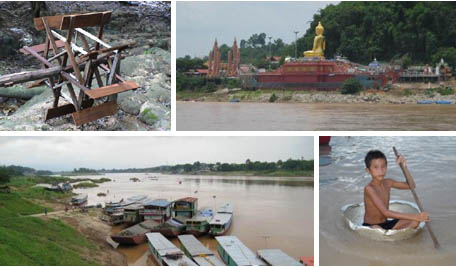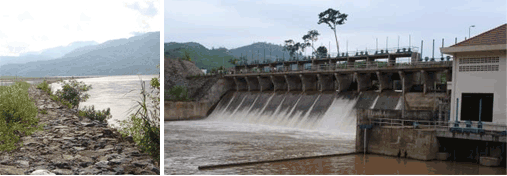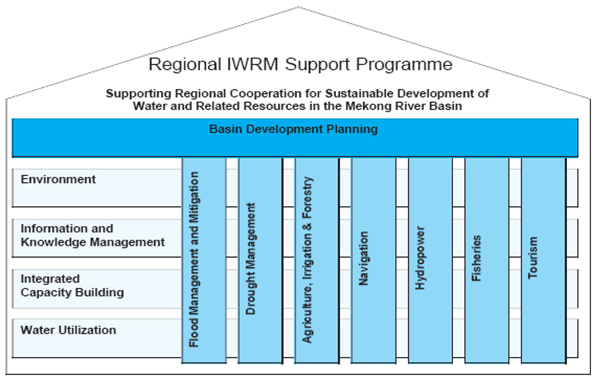Basin Development Plan

- BDP Phase 2
- Challenges
- BDP contribution to the MRC Strategic plan 2006-2010
- Partnership and stakeholder involvement
- Next steps
Participate in the Mekong basin development planning process: stay informed and make submissions. Find out more »
What is the Basin Development Plan?
The 1995 Agreement charges the Mekong River Commission Joint Committee with the formulation of a Basin Development Plan (BDP) “to promote, support, cooperate and coordinate in the development of the full potential of sustainable benefits to all riparian States and the prevention of wasteful use of the Mekong Basin waters, with emphasis and preference on joint and/or basin-wide development projects and basin programmes”. The purpose of the BDP is therefore to identify, categorise and prioritise projects and programmes at the basin level.
Using the principles of Integrated Watershed Resource Management (IWRM), the BDP process promotes the coordinated development and management of water and related resources, in order to maximise economic and social welfare in a balanced way without compromising the sustainability of vital ecosystems (Global Water Partnership, 2000). This requires the preparation of information that informs discussion and decisions on achieving an acceptable balance between development of the basin and maintenance of its ability to sustain livelihoods and environmental values.
The IWRM-based BDP comprises three elements:
- Development Scenarios, which assess the potential and constraints for the further development of some of the water resources in the various parts of the Mekong Basin. The results will guide the formulation of the IWRM-based Basin Strategy and the project portfolio.
- An IWRM-based Basin Strategy, which provides a long-term view of how the Mekong Basin may be developed in a sustainable manner for poverty reduction. The strategy will also guide the implementation of the IWRM at basin, national and sub-basin levels, and assist line agencies with preparation of plans and projects that are sensitive to resource protection issues.
- A project portfolio of structural (investment) projects and supporting non-structural projects, as envisioned in the 1995 Agreement, to develop some of the Mekong Basin’s water and related resources and minimise harmful effects that might result from natural occurrences and man-made activities.

Why is a Basin Development Plan Needed?
Key Elements of the IWRM-based
Basin Development Plan

The diagram on the right shows how the three elements of the BDP will be prepared with support from the National Mekong Committees, national line agencies, and other MRC programmes.
Despite impressive economic growth over the past decade, the Mekong Basin remains among the world's poorest areas, with poverty affecting up to 40% percent of the population in certain parts. An estimated population increase of 30-50% by 2025 will bring the number of people in the Basin to over 100 million, meaning that pressure on natural resources will increase, as will demand for food, water and energy.
Water resource development in the Mekong Basin is still limited if compared with most other large river basins. The governments of the basin countries are increasingly recognising that sustainable development of the economic potential of the Mekong river system - for domestic use, fisheries, hydropower, navigation, irrigation, and flood management - can alleviate poverty and improve livelihoods. Such development must be undertaken with equal consideration to conserve riverine ecology. The people of the Mekong Basin rely on rivers and their natural systems, which include the world's largest fresh water fishery. The planning process requires a strong partnership of basin stakeholders to effectively link water resource development with conservation of the basin's rich riverine ecology.
The MRC BDP provides such a planning process, designed to help the Lao PDR, Thailand, Cambodia and Vietnam achieve their goals of economic prosperity, environmental sustainability and social equity, as described in the 1995 Mekong Agreement. The development and management of water and related resources will be vital to attaining these goals.
How Does Basin Development Planning Work?
The BDP approach considers the basin-wide development opportunities and constraints that arise through sharing the resources of the Lower Mekong Basin. The planning process comprises seven stages in a rolling cycle:
Stage 1: Analysis of common issues such as hydropower, irrigation, flooding, fisheries, navigation, environment in the Lower Mekong Basin and its sub-areas, including review of policies and plans at national level and development of planning frameworks at sub-area levels;
Stage 2: Formulation and assessment of basin-wide development scenarios;
Stage 3: Formulation of strategies to guide basin development and management, based on IWRM principles;
Stage 4: Development of a database of planned and identified projects;
Stage 5: Screening, ranking and prioritisation of projects to compile the project portfolio;
Stage 6: Preparation of the IWRM-based BDP by integrating the development scenarios, IWRM-based basin strategy and project portfolio into a coherent and consistent plan; and
Stage 7: Supporting the promotion and implementation of projects, monitoring BDP implementation, and periodically evaluating and updating the Plan.
The BDP employs existing and proven tools alongside improved methods to ensure benefits for all member countries, and to see that projects comply with sound environmental and socioeconomic principles and are free of transboundary conflict. The Plan will bring all existing, ongoing, planned and potential significant water and water-related resource developments into the planning process. Alternative development scenarios will assess the likely benefits and costs to the member countries of different levels of resource development across the basin. The resulting strategic development options for meeting the water needs of all sectors, and the needs of the Mekong River itself, will be subject to basin-wide discussions with the various interest groups.
This planning process provides a platform for the MRC to visibly engage in transboundary assessment, based on IWRM, and helps guarantee that an acceptable balance will be maintained between resource development and resource protection. The Plan will be implemented by the countries and their development partners. The MRC’s contribution to the preparation and implementation of structural projects includes:
• Review of terms of references, feasibility studies
and environmental impact assessments;
• Transboundary impact assessments and monitoring;
• Trade-off facilitation and dispute prevention; and
• Monitoring the condition of basin resources through
the periodic State of the Basin Report.
This assistance further strengthens the MRC’s role in transboundary governance, and ensures that projects do not cause conflicts. It is envisioned that many of the non-structural projects in the plan will be implemented by the MRC within the existing programmes.
During the planning process gaps identified in the knowledge base will be addressed and a comprehensive planning atlas and updated State of the Basin Report prepared. The planning process will be supported by IWRM planning courses and workshops delivered by the MRC’s Integrated Capacity Building Programme and selected institutions in the basin countries. Training topics include the formulation and evaluation of development scenarios, use of MRC modelling and assessment tools and processes, integration and harmonisation of planning across sectors and areas, and dispute and trade-off facilitation.
What are Scenarios?
Scenarios are used to compare various “what if” cases. They provide a structured method of thinking about possible future water resource development and management options, opportunities and risks, and how these interact. The results are useful for consensus building and decision making.
Scenarios are usually built from a combination of facts and possible changes, situations or future series of events. Development scenarios for BDP purposes are defined by assumptions of:
(1) future hydrological conditions;
(2) future water demands; and
(3) interventions assumed to be in place.
Analysis of these assumptions can show how water resource regimes will alter, along with the resulting positive and negative economic, environmental and social implications.

The number of development scenarios to be developed and assessed should be kept to a minimum. Major stakeholders in the member countries must be involved in the formulation and assessment of these scenarios. In the BDP Programme, local opinions concerning desired future situations are captured by analysis and planning activities in ten BDP sub-areas, each of which comprises one or more tributary basins.
Under the BDP, each development scenario will be formulated for the entire basin to represent various levels of resource development in the various sub-basins during the next two decades. The basin-wide development scenarios will be based on many factors, including national plans for water and related resource development, population and economic growth, investments and trade, poverty reduction, and other issues in national policies and socio-economic plans. Some development scenarios will examine the longer term consequences of climate and land use changes, and how road development and other innovations will change the water resource situation.
The positive and negative impacts each scenario will be assessed by applying sound professional analysis and judgement. Proven modelling and assessment tools (such as the MRC Decision Support Framework or DSF) and newly improved mechanisms (such as the Integrated Basin Flow Management process) will be used to assess the likely benefits and costs of each formulated scenario, and its contribution to achieving the Millennium Development Goals for sustainable development and poverty alleviation.
These assessments will be used to prepare a few strategic options for meeting the water needs of all sectors. The strategic options will form the subjects of basin-wide discussions with various interest groups. Ultimately, senior government officials from the Member States must provide guidance on the level of basin development preferred. The achieved consensus among the member countries on how the basin will be developed will inform the IWRM-based Basin Strategy.

What Has Been Achieved So Far?
The first phase of the BDP (2001-2006) achieved much in terms of establishing processes and creating a framework for participatory planning. It made good progress in the improvement of the knowledge base and tools for water resources development planning. It also established a project database that contains screened and prioritised projects, some of which are being implemented or prepared for implementation with support from development partners.

The results were prepared with the active participation of many participants, structured around the regional BDP team at the MRCS together with national BDP teams and working groups under the four National Mekong Committees. National ownership of the planning process was encouraged and institutional capabilities strengthened. Virtually all MRC programmes are becoming gradually involved in the BDP process. The BDP Phase 1 Completion Report provides a useful overview of these achievements, as shown in the box 1 below.
Phase 1 of the BDP produced:
(1) A planning process consisting of
- A functional, comprehensive network of participants and information flows, consolidated during active dialogue involving 200 institutional stakeholders;
- Routines for identification, scoping and screening of recommended projects and programmes;
- Initial practices for promotion and facilitation of priority projects and programmes.
(2) A knowledge base, comprising data and information for planning, including the following publications:
- MRC State of the Basin Report (June 2003);
- MRC Social Atlas (May 2003);
- MRC People & Environment Atlas (Aug 2003);
- The BDP Planning Atlas, produced by a GIS-linked database, with a wealth of data; and information, and listings of development projects and project ideas (May 2006);
- Stakeholder Participation
- The BDP Core Library (May 2006)
(3) Modelling and assessment tools, such as a GIS-linked project database, a project screening toolkit, the Decision Support Framework (developed by the Water Utilisation Programme), and a Resources Allocation Model for the assessment of development scenarios.
(4) Plan setting, consisting of:
- Broad integrated analyses, at sub-area, national and basin-wide levels, of baseline conditions, water demand projections, development opportunities, linkages and constraints;
- Approved 'Strategic directions for IWRM in the Lower Mekong Basin', reflecting values shared by the Member States, and addressing immediate, medium and long-term water-related development; and
- Categorised and prioritised projects and programmes that will support the strategic directions and the MRC vision of 'an economically prosperous, socially just and environmentally sound Mekong River Basin'.
(5) Enhanced understanding of IWRM principles at the regional, national and sub-area levels, provided by:
- Dedicated training sessions and on-the-job training;
- The MDBC training programme and curriculum;
- Six riparian MSc candidates educated under BDP-related grants.
BDP Programme Phase 2
The second phase of the BDP Programme (2006-2010), due to start full operations in 2008, is designed to institutionalise the participatory planning process established during BDP Phase 1 and further develop the assessment tools and IWRM-based planning capacity to produce a rolling IWRM-based Basin Development Plan. The three immediate objectives of BDP Phase 2 are:
- A rolling IWRM-based Basin Development Plan produced in support of sustainable development in the Mekong River Basin.
- Knowledge base and assessment tools further developed and used effectively in the MRCS, in National Mekong Committees (NMC) and in selected line agencies.
- Capacity built at MRC and NMC levels for IWRM planning and facilitation/mediation in areas where trade-off management is required.
In line with these immediate objectives, BDP Phase 2 has four components:

Component 1: Programme Management and Communication. Besides programme management, this component will support communication, coordination, and information exchange with the various stakeholder groups, including MRC programmes, NMCs, national line agencies, river basin and civil society organisations, NGOs, the private sector, development banks and others.
Component 2: Rolling IWRM-based Basin Development Plan. This component will prepare the basin-wide development scenarios, the IWRM-based basin strategy, and the project portfolio. The component will also address gaps in sector knowledge and support the next steps of sub-basin planning.
Component 3: Knowledge Base and Assessment Tools. This component will further upgrade the existing knowledge base and selected modelling and assessment tools, such as the DSF, and the checklists for the screening of individual projects. It will also continue to build capacity for the maintenance and use of tools by the NMCs and selected national and sub-basin agencies.
Component 4: IWRM-based Planning
Capacity. This component will build capacity for IWRM planning,
including scenario formulation and analysis, project identification
and preparation, the linking and harmonisation of planning across
sectors and areas, and trade-off facilitation and dispute prevention.
The component will also explore IWRM training capacity in local
institutions.
- Formulated and assessed basin-wide development scenarios, which facilitate the establishment of a shared understanding of development options in the Lower Mekong Basin and help define the IWRM-based strategy for basin development and management;
- An updated IWRM-based basin strategy to guide the implementation of IWRM in the Lower Mekong Basin;
- A portfolio of programmes and projects identified and short listed under the planning cycle;
- A rolling IWRM-based Basin Development Plan;
- Enhanced knowledge base with updated State of the Basin Report and a planning atlas;
- Upgraded assessment tools and process for use by the MRC and national line agencies in the planning process; and
- Updated planning guides and enhanced capacity for IWRM-based planning.
Challenges
The main challenge is to build a sustainable planning process that will enable development of subsequent editions of the IWRM-based Basin Development Plan with greater reliance on local resources. The connections between the MRC programmes and national planning and line agencies are seen as pivotal to the establishment of an integrated planning process that links all levels of planning in the basin.
The MRC sector programmes have an overarching objective of promoting wise use of resources in their respective sectors through appropriate development projects. It is expected that they will increasingly influence, promote and, where appropriate, participate in national planning within the framework of the BDP. The Plan will use acquired knowledge from MRC programmes to build an overall perspective of basin management and development needs. This will eventually set the agenda for MRC programmes.
As the chart shows, the BDP overarches MRC sector and service programmes to form a powerful initiative for supporting IWRM across the Lower Mekong Basin.

BDP Contribution to the MRC Strategic Plan 2006-2010
The centre piece of the MRC’s current strategy is a ‘rolling’ plan for developing and managing the Basin’s water resources, founded on IWRM principles, and with a socially and environmentally sound agenda to promote regional cooperation. The BDP Programme provides this basin-wide planning process plus opportunities to build a strong partnership of stakeholders who can effectively link development and natural resource conservation.
Programme outputs will contribute to the achievement of all
four MRC strategic goals. The BDP also assists implementation
of the MRC Strategic Plan by supporting:
1) Improvement of the coordination and programming of other
MRC programmes towards achieving the organisation’s strategic
goals;
2) The visible engagement of the MRC in transboundary assessment,
based on IWRM.
Partnership and Stakeholder Involvement
The BDP supports national socio-economic development policies and adds value to national development efforts through initiatives that affect more than one country. Through the National Mekong Committees in each country, the programme has developed close links with line agencies and stakeholders in the ten BDP sub-areas. Phase 2 will foster these relations by bringing the MRC sector programmes closer to these national and local planning partners. The BDP will continue to put stakeholder participation and communication at the heart of its activities to facilitate acceptance of the Plan and support for its implementation.
The BDP also maintains links with and supports other regional initiatives including the World Bank/ADB Mekong Water Resources Assistance Strategy, various ASEAN and Greater Mekong Sub-Region projects, the Global Water Partnership and UNESCAP. The BDP Programme (phases 1 and 2) has received financial and technical support from Denmark, Australia, Japan, Sweden and Switzerland.
Next Steps
After a period of reassessing progress from the first phase and meeting staffing needs, the BDP Programme is now well equipped to forge ahead. Recruitment of a new regional team has been completed and national BDP teams mobilised. An inception report for the second phase of the programme was prepared and discussed in national and regional consultation meetings.
In February 2008, the BDP Programme will be discussed in a
regional consultation meeting with stakeholders from NGOs, academia,
development partners and the private sector. This will place
the plan in the broader development context of the region.
Choose a newsletter:
 Top
Top


